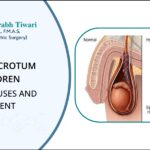In recent years, pediatric laparoscopic surgery has undergone significant advancements, transforming the landscape of surgical care for children. This minimally invasive technique not only reduces trauma but also promotes faster recovery times, ensuring better overall outcomes for young patients. As parents, understanding these advancements and their implications for your child’s health is crucial.
What is Pediatric Laparoscopic Surgery?
Pediatric laparoscopic surgery, often referred to as keyhole surgery, is a minimally invasive surgical technique used to treat various conditions in children. Instead of making large incisions, surgeons make small cuts and insert a camera (laparoscope) along with specialized instruments to perform the procedure. This method significantly reduces post-operative pain, scarring, and recovery time compared to traditional open surgery.
Benefits of Laparoscopic Surgery for Children
- Reduced Scarring – The small incisions required for laparoscopic surgery result in minimal scarring, which is particularly important for growing children.
- Faster Recovery Time – Children tend to recover more quickly from laparoscopic procedures, often returning to their regular activities much sooner.
- Less Pain and Discomfort – The smaller incisions lead to less postoperative pain, reducing the need for pain medication.
- Lower Risk of Infection – Since the incisions are smaller, there is a reduced risk of infection compared to traditional surgery.
- Improved Accuracy and Precision – The use of high-definition cameras and advanced instruments allows surgeons to perform the surgery with greater accuracy, resulting in better outcomes.
Common Conditions Treated with Pediatric Laparoscopy
- Appendicitis – Laparoscopic appendectomy is a common procedure for children with appendicitis, offering a quicker recovery and minimal scarring.
- Hernias – Inguinal hernias, which occur when a portion of the intestine protrudes through the abdominal wall, can be repaired using laparoscopic techniques.
- Gastroesophageal Reflux Disease (GERD) – Laparoscopic surgery is used to correct severe GERD in children, reducing symptoms and improving quality of life.
- Cholecystitis – When a child experiences inflammation of the gallbladder, laparoscopic surgery can remove the gallbladder with minimal disruption.
- Intestinal Obstructions – Laparoscopic techniques are used to remove blockages in the intestines, improving digestive function and reducing complications.
Technological Advancements in Pediatric Laparoscopy
3D Laparoscopy
One of the most significant advancements in pediatric laparoscopic surgery is the introduction of 3D imaging technology. Surgeons now have access to three-dimensional views of the surgical area, providing enhanced depth perception and spatial awareness. This improved visualization allows for more precise movements, reducing the risk of errors and enhancing surgical outcomes.
Robotic-Assisted Laparoscopy
Robotic-assisted laparoscopic surgery is another exciting development in pediatric surgery. Robotic systems enable surgeons to perform complex procedures with greater precision and control. The robotic arms, controlled by the surgeon, can make smaller and more delicate movements than the human hand, which is particularly beneficial in pediatric cases where precision is paramount.
Single-Incision Laparoscopic Surgery (SILS)
Single-incision laparoscopic surgery (SILS) is a newer technique where surgeons perform the entire procedure through one small incision, typically at the belly button. This innovation further reduces scarring and postoperative pain, making it an attractive option for many pediatric patients.
Image-Guided Surgery
The use of image-guided surgery in pediatric laparoscopy has enhanced the surgeon’s ability to navigate complex anatomy with greater accuracy. By using real-time imaging, surgeons can avoid critical structures and improve the safety and effectiveness of the procedure.
Preparing Your Child for Laparoscopic Surgery
As a parent, preparing your child for surgery can be a daunting task. However, understanding what to expect can alleviate some of the anxiety.
- Preoperative Consultation: Before the surgery, you’ll meet with the surgical team to discuss the procedure, risks, and recovery process. This is an opportunity to ask any questions and ensure that you and your child are fully informed.
- Anesthesia: Pediatric laparoscopic surgeries are typically performed under general anesthesia, meaning your child will be asleep throughout the procedure. The anesthesiologist will closely monitor your child’s vital signs to ensure safety.
- Pre-Surgery Instructions: Your surgeon will provide specific instructions for your child’s preparation, including fasting guidelines and any medications that need to be paused or started before the procedure.
Postoperative Care and Recovery
Recovery after pediatric laparoscopic surgery is generally quicker and less painful compared to traditional surgery. However, it’s important to follow the postoperative care instructions provided by your child’s surgical team.
Pain Management
Although laparoscopic surgery involves smaller incisions, some discomfort is normal during the recovery process. Your surgeon will prescribe appropriate pain relief medications to help manage any discomfort your child may experience.
Activity Restrictions
Depending on the surgery, your child may need to avoid strenuous activities for a few weeks. It’s essential to follow the activity restrictions your surgeon recommends to ensure a smooth recovery.
Wound Care
Proper care of the surgical site is critical to preventing infection. Your surgeon will provide specific instructions on caring for the incisions, including keeping the area clean and dry.
Must Read – Post-Surgery Care for Children: What Parents Need to Know
Risks and Considerations
While pediatric laparoscopic surgery is generally safe, like all surgeries, it comes with certain risks. Potential complications include:
- Bleeding
- Infection
- Injury to surrounding organs
- Adverse reactions to anesthesia
Pediatric laparoscopic surgery has revolutionized the way we approach surgical care for children. Combining minimally invasive techniques, cutting-edge technology, and enhanced precision has significantly improved outcomes for young patients. As parents, staying informed about the latest advancements in pediatric surgery allows you to make the best decisions for your child’s health.
Consult Dr. Saurabh Tiwari, a renowned pediatric surgeon in Goregaon, Malad, Andheri, and Jogeshwari, is dedicated to providing exceptional care for children.




